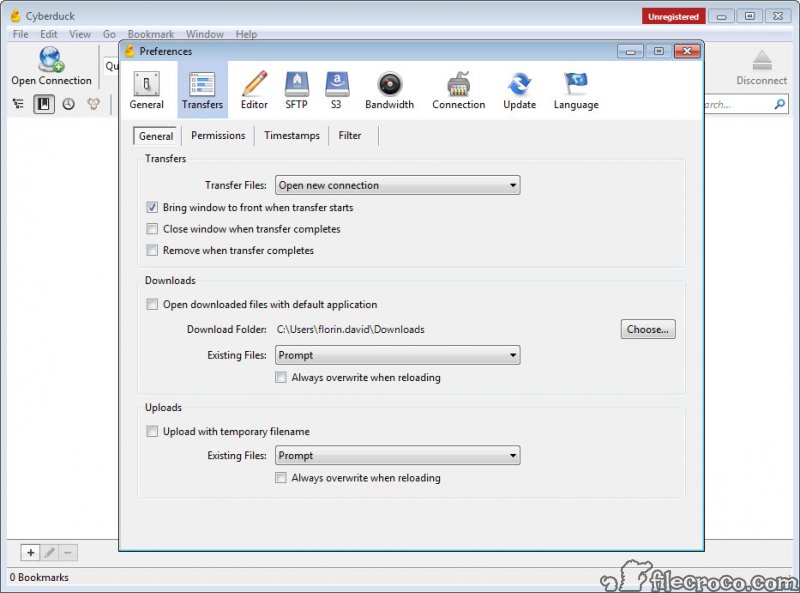
- Setup ssh tunnel with cyberduck how to#
- Setup ssh tunnel with cyberduck license#
- Setup ssh tunnel with cyberduck free#
- Setup ssh tunnel with cyberduck mac#
Are there future plans to add this? Is it deferred? Is it technically not feasible? Skipped due to the availability of workarounds? Not enough demand? Not interested, etc. It would be helpful if CyberDuck supported the Prox圜ommand ssh config option, or at least would explain their position on the matter, in any case (I.e. redundant ssh encryption of the I/O streams). The downside of this workaround might be an avoidable performance hit (e.g. to localhost:), and whalla - CyberDuck now has access to a host on the VPN. Once entered, you will be logged into the remote server, and the SSH tunnel will be established.
Setup ssh tunnel with cyberduck mac#
Once a tunnel is running that bridges the Mac to a host on VPN via the the VPN-connected remote host (lets call it the proxy), I connect with Cyberduck running on the mac to the tunnel port on same mac Cyberduck running on (e.g. To do so, you can forward the connection using the following command: ssh -L 3336:db001.host:3306 userpub001.host Once you run the command, you’ll be prompted to enter the remote SSH user password. (many examples of setting up that kind of tunnel, online). WORKAROUND: I set up an ssh tunnel daemon using the Mac "SSH Tunnel" app (paid app) from the App Store, using the app as convenient way to track and manage tunnels (in my case, all one of them), but no magic there, it's just uses ssh -L. But I found the Prox圜ommand setting that works perfectly with BBEdit's SFTP infrastructure, doesn't work with Cyberduck. Specifically, I wanted CyberDuck on my Mac to have access to hosts on a VPN that only a remote (but locally accessible) host had access to. If (-not $env:PATH.I found myself desperately needing to access a VPN that was connected to on a remote host, from my localhost (Mac). And use a powershell script to keep it up is:
Setup ssh tunnel with cyberduck license#
P圜harm Professional student license will.

Setup ssh tunnel with cyberduck free#
To start using it you need a config like this: # LocalPort TargetHost TargetPort SshHost SshUsername SshKeyPathġ8080 80 User D:\secure\path\to\private_key.ppk TOOLS openSSH allows ssh connections ngrok is a free tunneling service, though reserved subdomains start at 5/mo. That's why I come up with custom Powershell script, easy configurable, changeable, small, but works. I tried many solutions like SSH tunnel managers, but all were inconvinient for me: too many configuration screens, sometimes buggy (one time SSH tunnel manager purged all! settings I had! So I had to restore settings for all 30 tunnels).
Setup ssh tunnel with cyberduck how to#
I did find this question: How to reliably keep an SSH tunnel open?, but that's using Linux as the SSH client, and I'm using Windows.

I'm planning on making a dedicated user with no privileges and not allowed to interactively log in, and use that.) (Yes, I am aware of the hazards of automatically logging in to SSH. cyberduck ssh tunnelnew mexico state police shooting cyberduck ssh tunnel Menu father ronald coyne. The two tunnels are one local tunnel, and one remote tunnel. The data I'm sending across the two tunnels is VNC connections, so I often won't be at the machine to clear errors and enter passwords. What I'd like to do is have an application that can set up the two SSH tunnels, and can automatically reconnect, without needing to manually do anything, including enter a password. This works well, except when the SSH connection drops: PuTTY displays an error message, and I need to manually close the error and reconnect to the server. Remote port forwarding is the opposite of local port forwarding. I'm trying to set up a Windows computer to always have two SSH tunnels to my Linux server.Ĭurrently, I'm using PuTTY to open the two SSH tunnels: I log in to the server in PuTTY, leave it minimized, and never touch it. You can set up a local port forwarding SSH tunnel to forward traffic from your local machine’s port to the remote server’s port: 1. Once a tunnel is running that bridges the Mac to a host on VPN via the the VPN-connected remote host (lets call it the proxy), I connect with Cyberduck running on the mac to the tunnel port on same mac Cyberduck running on (e.g.


 0 kommentar(er)
0 kommentar(er)
